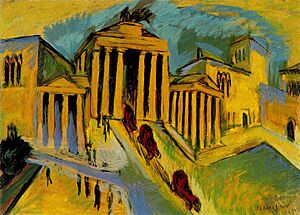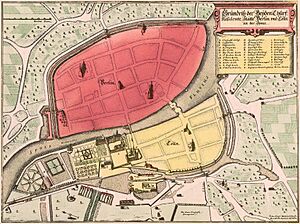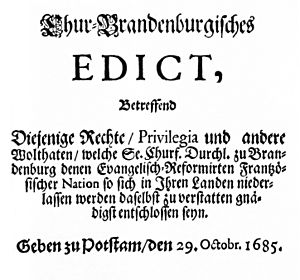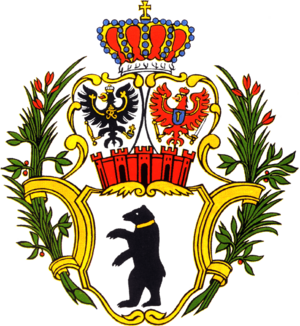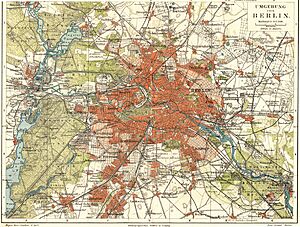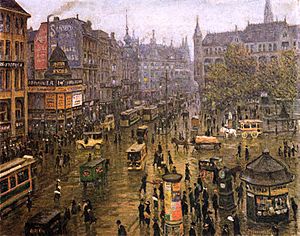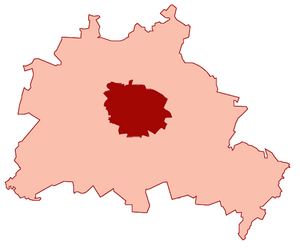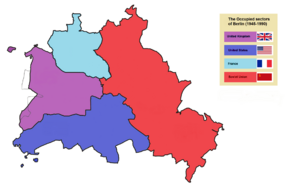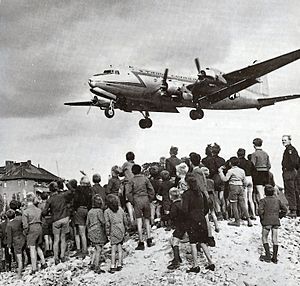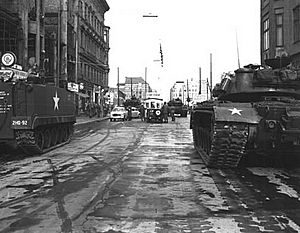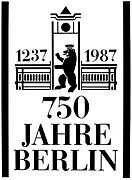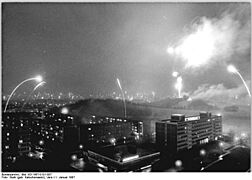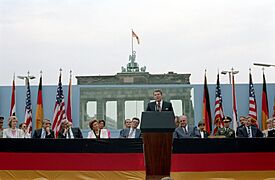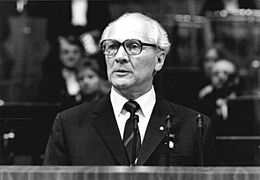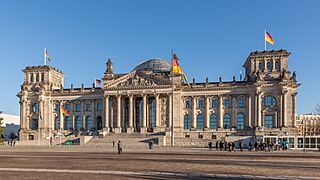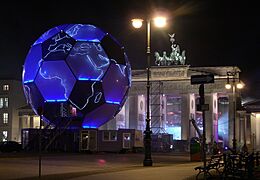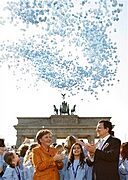History of Berlin facts for kids
The story of Berlin began in the 1300s. It became the capital of the Margraviate of Brandenburg in 1417. Later, it was the capital of Brandenburg-Prussia and the Kingdom of Prussia. Prussia grew very quickly in the 1700s and 1800s. It formed the basis of the German Empire in 1871. This empire lasted until 1918, when it was defeated in World War I.
After 1900, Berlin became a major world city. It was known for its leadership in science, arts, music, museums, and education. It was also important for government, diplomacy, and military matters. Berlin also played a role in making goods and in finance.
During World War II, many parts of Berlin were destroyed. This was due to bombs, artillery, and fierce street fighting. After the war, Berlin was divided among the four main Allied powers. For over 40 years, it was a symbol of the Cold War between West and East. When Germany reunited in 1990, Berlin became the capital again. It also became a major world city once more.
Contents
- What Does "Berlin" Mean?
- Early History
- How Berlin Became a City (1100s–1400s)
- Brandenburg's Capital (1400s–1700s)
- Kingdom of Prussia (1701–1871)
- German Empire (1871–1918)
- Weimar Republic (1918–1933)
- Nazi Germany (1933–1945)
- West and East Germany (1945–1990)
- Federal Republic of Germany (1990–Today)
- Population Over Time
- See Also
What Does "Berlin" Mean?

The exact meaning of the name Berlin is not fully known. It might come from an old Slavic word, berl-, which means "bear." People used to avoid saying the word "bear" because they thought it would summon the animal. So, they used other names for it.
Another idea is that the name comes from an old Slavic word meaning "swamp." A bear is also on the city's coat of arms.
Early History
The oldest signs of humans in the Berlin area are arrowheads from about 9,000 BC. Many villages existed here during the Stone Age. Later, during the Bronze Age, the area was part of the Lusatian culture. Around 500 BC, Germanic tribes lived in villages in the higher parts of what is now Berlin. Most of these tribes left around 500 AD.
In the 600s, Slavic tribes arrived. These were the Hevelli and Sprevane people. Their main settlements were in areas known today as Spandau and Köpenick. No Slavic traces have been found in the very center of Berlin.
How Berlin Became a City (1100s–1400s)
In the 1100s, the area came under German rule. This was part of the Margraviate of Brandenburg, started by Albert the Bear in 1157. By the late 1100s, German merchants built the first towns in the city center. These were called Berlin (near Nikolaiviertel) and Cölln (on an island in the Spree River, now Museum Island).
It's not clear which town was older or when they got official town rights. Berlin was first mentioned as a town in 1251, and Cölln in 1261. The year 1237 was later chosen as the founding year. The two towns later joined to form Berlin-Cölln in 1432. Albert the Bear also gave Berlin the bear emblem, which is still on its coat of arms. By 1400, Berlin and Cölln had 8,000 people.
Brandenburg's Capital (1400s–1700s)
In 1415, Frederick I became the elector of Brandenburg. The Hohenzollern family ruled Berlin until 1918. They were first electors, then kings of Prussia, and finally German emperors. When Berlin became their home, it lost its special status as a free city in the Hanseatic League. Its economy changed from trade to making luxury goods for the royal court.
- 1443 to 1451: The first Berliner Stadtschloss (royal palace) was built by the Spree River. Berlin-Cölln had about 8,000 people.
- 1448: People in Berlin protested against building a new palace. This protest was not successful, and citizens lost some rights.
- 1451: Berlin became the royal residence, losing its free city status.
- 1510: Some Jews were accused of crimes. Many were killed, and others were forced to leave.
- 1530: The Tiergarten park began as a royal hunting ground. It opened to the public in the mid-1600s.
- 1539: The electors and Berlin officially became Lutheran.
- 1576: The Bubonic plague killed about 6,000 people in the city.
- Around 1600: Berlin-Cölln had 12,000 people.
- 1618 to 1648: The Thirty Years' War badly damaged Berlin. A third of the homes were destroyed, and the city lost half its people.
- 1640: Frederick William, known as the "Great Elector," became ruler. He encouraged people to move to Berlin and allowed different religions.
- 1647: The famous street Unter den Linden was created with six rows of trees.
- 1671: Fifty Jewish families from Austria were welcomed in Berlin.
- 1685: Frederick William invited French Calvinist Huguenots to Brandenburg with the Edict of Potsdam. Over 15,000 Huguenots came, with 6,000 settling in Berlin. By 1687, they made up 20% of the population. Many were bankers and business owners.
- Around 1700: Many refugees from other parts of Europe arrived in Berlin.
Kingdom of Prussia (1701–1871)
In 1701, Elector Frederick III crowned himself Frederick I, King in Prussia. He ordered the building of Charlottenburg castle. He made Berlin the capital of the new Kingdom of Prussia.
- 1709: Berlin had 55,000 people. Cölln and Berlin finally joined together as "Berlin." This included the suburbs of Friedrichswerder, Dorotheenstadt, and Friedrichstadt. The city now had 60,000 people.
- January 1, 1710: The cities of Berlin, Cölln, and their suburbs officially united as the "Royal Capital and Residence of Berlin."
Berlin as Prussia's Capital
As Prussia grew, so did Berlin. Kings made it a center for culture, arts, and the Army. Under King Friedrich Wilhelm I (1713–1740), Berlin's growth was encouraged. He wanted to build a strong military. He promoted immigration of Protestants from other countries. He also started universal primary education so soldiers could read and write. In 1720, he built the city's first major hospital and medical school, the Charité.
Berlin became a city focused on military supplies. The old defensive walls were torn down. A new customs wall was built further out with 14 fancy gates. Inside these gates were parade grounds for soldiers.
In 1740, Frederick the Great (Frederick II) began his 46-year rule. He was an enlightened ruler who supported thinkers like Moses Mendelssohn. By 1755, Berlin's population reached 100,000, including 26,000 soldiers.
- 1806: French troops marched into Berlin. Berlin gained self-government, and military reforms began.
- 1809: The first elections for the Berlin parliament took place. Only wealthy people could vote.
- 1810: The Berlin University (now Humboldt University) was founded.
- 1812: Jews were allowed to work in all jobs.
- 1814: The French were defeated. Berlin's economy was strong. The population grew from 200,000 to 400,000 in the first half of the 1800s. This made Berlin the fourth-largest city in Europe.
- 1848: Like other European cities, Berlin had a revolution in 1848. King Frederick William IV stopped it. He then made it harder to vote, so only 5% of citizens could vote. This system lasted until 1918.
- 1861: German Emperor Wilhelm I became the new king. He appointed liberal ministers and built the city hall, Das Rote Rathaus. But the appointment of Otto von Bismarck ended hopes for more freedom.
Economic Growth
Prussia's policies helped factories grow. Berlin had many small workshops. Since there wasn't much waterpower, Berlin businesses were among the first to use steam engines after 1815. Textiles, clothing, farm tools, railway parts, chemicals, and machines were very important. Electrical machines became important after 1880.
After 1850, Berlin's central location in Germany's growing railway network made it easy to get raw materials and send out finished goods. As the Prussian government grew, so did its efficient civil service. The government and military expanded even faster when Berlin became the capital of unified Germany in 1871. The population grew quickly, from 172,000 in 1800 to 826,000 in 1870. In 1861, industrial suburbs like Wedding and Moabit became part of the city.
Religion
By 1900, about 85% of Berliners were Protestants, 10% were Roman Catholics, and 5% were Jews. Middle and upper-class Berliners were usually religious Protestants. Working-class people became less religious. Labor unions often spoke against Protestant churches, saying they didn't care about workers. However, Catholic workers stayed closer to their churches.
Berlin Romanticism
A period of German Romanticism is called Berlin Romanticism. Important people in this movement included Friedrich Schleiermacher, Wilhelm von Humboldt, and Alexander von Humboldt.
German Empire (1871–1918)
Imperial Capital
After Germany won the war against France in 1870, the German Empire was created in 1871. Prussia became the largest and most powerful state in this new empire. Germany then became the strongest nation in Europe. Wilhelm I became emperor. Bismarck became Chancellor and made Berlin the center of European power. The government and military grew a lot. In 1884, the parliament building, the Reichstag, was built.
In 1870, Berlin's sanitation was very bad. Waste water flowed in street gutters, causing terrible smells. There were no public toilets. After 1870, the government brought in scientists and engineers to build a modern sewer system. By 1906, Berlin was seen as a model city, known for its "complete application of science, order and method of public life."
Berlin became an industrial city with 800,000 people. The city needed better transportation. In 1896, construction of the subway (U-Bahn) began, finishing in 1902. Areas around the city center were filled with apartment buildings. Industrial areas grew east of Berlin, and wealthy homes were built in the southwest.
Berlin also became a major cultural center. Museums were built and expanded. Berlin had many theaters, showing modern plays.
Labor Unions
Berlin had many industrial workers by 1871. It became the main place for most national labor organizations. Many local unions focused on wages and working conditions. By the 1870s, the labor movement in Berlin supported radical socialism. Germany had universal voting rights for men after 1871. However, Chancellor Otto von Bismarck tried to weaken the union movement.
First World War
When World War I started in 1914, many educated people supported the war. But hopes for a quick victory soon ended. The war became a long, deadly fight. There were no preparations for a long war, and no supplies. Industry was in chaos, and unemployment rose. In 1916, the Hindenburg Program called for using all economic resources for war production. Church bells and copper roofs were melted down.
Life at home got worse each month. The British blockade stopped supplies of raw materials and food. Many farmers and horses were sent to war, reducing food. Coal was also short. Factories made army uniforms, so warm clothes for civilians were scarce. People used paper and cardboard for cloth and leather, but it wasn't good. Soap and hot water were also in short supply.
People's spirits kept sinking. Berlin's government ran an efficient rationing system. Food focused on potatoes and bread, as meat was hard to get. Meat rations fell to 12% of peacetime levels by late 1918. Fish rations disappeared by late 1917. Rations for cheese, butter, and other foods were less than 20% of normal. In 1917, the potato supply ran short, and Germans ate turnips. This "turnip winter" of 1917–18 was remembered with bitterness.
German women did not serve in the army. But many took paid jobs in factories. Even more volunteered. Housewives learned to cook without milk, eggs, or fat. Banks and government offices hired women for office jobs for the first time. By December 1917, half the workers in some industries were women. Factories set up canteens to feed workers and keep them productive. The food situation improved in 1918, but shortages continued. Many people moved to Berlin for work, causing crowded housing. Reduced coal meant everyone was cold. Daily life involved long hours, poor health, and little fun. People worried about loved ones in the army.
Weimar Republic (1918–1933)
At the end of World War I, Germany became a republic, called the Weimar Republic. Berlin remained the capital. But it faced threats from extreme political groups.
In late 1918, politicians inspired by the Russian Revolution formed the Communist Party of Germany. In January 1919, they tried to take power in the Spartacist revolt. The coup failed. Right-wing forces killed Communist leaders Rosa Luxemburg and Karl Liebknecht.
In March 1920, Wolfgang Kapp tried to overthrow the government. The Berlin military supported him, and government buildings were taken. But a general strike stopped the attempt.
- October 1, 1920: The Greater Berlin Act created "Greater Berlin." It added several nearby towns and villages like Charlottenburg and Spandau to the city. Berlin's population doubled overnight from about 2 million to nearly 4 million.
- 1922: Foreign minister Walther Rathenau was killed in Berlin. Half a million people attended his funeral.
The economy was bad. Germany had to pay war reparations. The government printed so much money that inflation was huge. People lost their savings. At its worst, one dollar was worth 4.2 trillion marks. From 1924, the situation improved with new agreements and American help. Berlin then had a golden age. It became the largest industrial city in Europe. People like architect Walter Gropius, physicist Albert Einstein, and writer Bertolt Brecht made Berlin a major cultural center. Nightlife boomed in the 1920s.
In 1922, Berlin's railway system was electrified and became the S-Bahn. A year later, Tempelhof airport opened. Berlin was the second-biggest inland port in Germany. All this infrastructure was needed for the over 4 million Berliners.
Before the 1929 stock market crash, 450,000 people were unemployed. That same year, the Nazi Party won its first seats in the city parliament. Nazi propaganda leader Joseph Goebbels became the Nazi party chief for Berlin in 1926. On January 30, 1933, Hitler became Chancellor of Germany.
Nazi Germany (1933–1945)
By 1931, the Great Depression had badly hurt Berlin's economy. Politics were chaotic, with Nazi and Communist groups fighting in the streets. President Hindenburg appointed Hitler chancellor in January 1933. The Nazis quickly took full control of the country. On February 27, 1933, the Reichstag building caught fire. This gave Hitler a chance to ignore the constitution. Thousands of political opponents fled or were jailed. All groups, except churches, came under Nazi control.
Around 1933, about 160,000 Jews lived in Berlin. This was one-third of all German Jews. They were persecuted from the start of the Nazi rule. In March, Jewish doctors had to leave the Charité hospital. In early April, Nazis told Germans not to buy from Jewish shops.
The 1936 Summer Olympics were held in Berlin. They were used to show off Nazi Germany. Signs saying "forbidden for Jews" were temporarily removed for foreign visitors.
Nazi rule destroyed Berlin's Jewish community. After the Kristallnacht attacks in 1938, thousands of Jews were imprisoned. Around 1939, 75,000 Jews still lived in Berlin. Most German Jews in Berlin were sent to death camps like Auschwitz in early 1943. Most were murdered in the Holocaust. Only about 1,200 Jews survived in Berlin by hiding.
Thirty kilometers northwest of Berlin, near Oranienburg, was Sachsenhausen concentration camp. Political opponents, Jews, Poles, and Russian prisoners of war were held there. Tens of thousands died. Sachsenhausen had 17 smaller camps in Berlin for prisoners who had to work in industries.
Nazi Plans
In the late 1930s, Hitler and his architect Albert Speer planned a new Berlin. It was to be a huge "world city" called Welthauptstadt Germania. All the buildings were to be gigantic. Speer planned to build the Volkshalle (People's Hall) near the Reichstag. It would be 250 meters high with a huge copper dome, big enough for 170,000 people. A long avenue, the Avenue of Victory, was planned to run south from it. At the end would be a new railway station. Halfway down the avenue, a huge arch 117 meters high would honor those who died in the world wars. Berlin was to be renamed "Germania" when these projects finished (planned for 1950).
The war stopped all construction. Instead, the city built giant concrete towers for anti-aircraft guns. Today, only a few Nazi-era buildings remain, like the Air Ministry, Tempelhof International Airport, and Olympiastadion. Hitler's Chancellery was torn down by Soviet authorities.
Second World War
- 1940: A small British air raid on Berlin on August 25, 1940. Hitler responded by ordering the the Blitz on London.
- 1943: The USAAF began bombing Berlin. The RAF focused its bombing on Berlin in the "Battle of Berlin" from November. This stopped in March 1944 after 16 large raids due to heavy losses for the attackers. About half a million people were left homeless. About a quarter of the city's population was moved out.
- March 1945: British bombers dropped 46,000 tons of bombs. Americans dropped 23,000 tons. By May 1945, 1.7 million people (40%) had fled.
- April 1945: Berlin was the main goal for Allied armies. The Race to Berlin was a competition among Allied generals to reach Berlin first. U.S. General Dwight D. Eisenhower stopped Anglo-American troops at the Elbe River. This was because the Soviets wanted to capture the city for prestige and revenge. The Red Army moved on Berlin. Hitler stayed in command, refusing to surrender.
- April 30, 1945: Hitler committed suicide in his bunker. Resistance continued, but most of the city was in Soviet hands.
- May 2, 1945: Berlin finally surrendered.
Many buildings and much of the infrastructure in the inner city were completely destroyed. Outer areas had less damage. On average, one-fifth of all buildings were destroyed, and 50% in the inner city.
West and East Germany (1945–1990)
By the end of the war, up to a third of Berlin was destroyed. This was due to Allied air raids, Soviet artillery, and street fighting. The "zero hour" marked a new beginning for the city. Greater Berlin was divided into four sectors by the Allies.
- The American sector (210.8 sq km) included Neukölln, Kreuzberg, Tempelhof, Schöneberg, Steglitz, and Zehlendorf.
- The British sector (165.5 sq km) included Tiergarten, Charlottenburg, Wilmersdorf, and Spandau.
- The French sector (110.8 sq km) included Wedding and Reinickendorf.
- The Soviet sector (402.8 sq km) included Mitte, Prenzlauer Berg, Pankow, Weißensee, Friedrichshain, Lichtenberg, Treptow, and Köpenick.
The Soviets occupied all of Berlin after the battle. They handed the American, British, and French sectors (later called West Berlin) to those forces in July 1945. Berlin remained divided until Germany reunited in 1990.
The Soviets dismantled industries and transport in West Berlin as war reparations. This continued in East Berlin and the Soviet zone. Conditions were harsh, and many refugees came from the east. People relied on the black market for food.
Berlin's unique position, half controlled by Western forces in the middle of the Soviet zone, made it a key point in the Cold War after 1947. The city was first governed by a council of the four powers. But the Soviets left the council as East-West relations worsened. They began governing their sector alone. The council continued to govern West Berlin with France, the UK, and the US.
East Germany chose East Berlin as its capital in October 1949. However, Western allies did not accept this. They still saw Berlin as an occupied city, not legally part of any German state. In practice, East Germany treated East Berlin as part of its nation.
West Germany, formed in May 1949, had its capital in Bonn. But Berlin was symbolically named the West German capital in its Basic Law. West Berlin remained under Allied rule. But for most purposes, it was treated as part of West Germany.
Blockade and Airlift
In response to Allied efforts to unite their parts of western Germany, the Soviets blocked ground access to West Berlin on June 26, 1948. This was known as the "Berlin Blockade". The Soviets wanted to control all of Berlin. The American and British air forces started a huge effort to supply West Berlin by air. This was called the Berlin Airlift, or "die Luftbrücke" (the Air Bridge) by West Berliners. The blockade lasted almost a year. It ended when the Soviets allowed ground access again on May 11, 1949.
As part of this, US Army engineers expanded Tempelhof Airport. Sometimes, planes delivered sweets for children. So, the planes were nicknamed "Candy Bombers."
The June 17 Uprising
After Stalin died, there was a plan to reunite Germany. A workers' demonstration was planned to remove a hardline leader. But the demonstrations grew huge. A strike for better wages became a revolution for democratic rights. On June 17, 1953, the Soviets used tanks to restore order. This started when 60 construction workers in East Berlin went on strike on June 16, 1953. They wanted less work. They called for a general strike the next day. The strike turned into riots across East Germany. East German police could not stop it. Soviet troops suppressed it with live ammunition. At least 153 people were killed.
The street "Unter den Linden" on the western side of the Brandenburg Gate was renamed Straße des 17. Juni to honor the uprising. June 17 became a national holiday in West Germany.
Berlin Wall
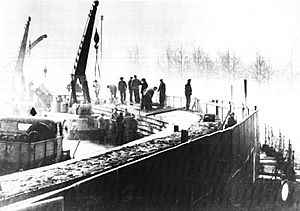
On August 13, 1961, the Communist East German government began building a wall. This physically separated West Berlin from East Berlin and the rest of East Germany. It was built because many East German citizens were fleeing into West Berlin. The wall was built overnight without warning. This separated families for as long as it stood. The East German government called it the "anti-fascist protection wall." Tensions between East and West grew, especially during a tank standoff at Checkpoint Charlie on October 27, 1961. West Berlin was now a part of West Germany, but with a special legal status. East Berlin remained part of East Germany.
The western parts of Berlin were completely cut off from East Berlin and East Germany. Westerners could only cross through strict checkpoints. Most Easterners could no longer travel to West Berlin or West Germany. While the Wall existed, about 5,000 people successfully escaped into West Berlin. Officially, 136 people were killed trying to cross, and about 200 were seriously injured. The sandy soil under the Wall made it easy to dig tunnels, but also made them likely to collapse.
When the first stone blocks were laid at Potsdamer Platz on August 13, US troops watched. They kept Berliners 300 meters from the border. President John F. Kennedy and the US Congress decided not to interfere and risk war. They protested to Moscow. Kennedy sent his vice president, Lyndon B. Johnson, to the city. Huge protests took place in West Berlin.
Almost two years later, on June 26, 1963, John F. Kennedy visited West Berlin. He gave a famous speech in front of the Schöneberg City Hall. He said, "Ich bin ein Berliner"– "I am a Berliner." This showed America's support for the city as a Western island in Soviet territory.
Much Cold War espionage happened in Berlin. In 1971, the Four-Power Agreement on Berlin was signed. This agreement guaranteed access across East Germany to West Berlin. It ended the risk of routes being blocked.
Many businesses did not want to operate in West Berlin due to its isolation. So, the West German government paid money to businesses that did operate there.
Student Movement
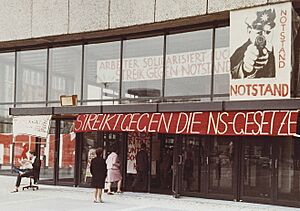
In the 1960s, West Berlin became a center for the German student movement. West Berlin was popular with young German left-wing activists. Young men living there were excused from military service required in West Germany. The Kreuzberg district became known for its many young activists.
The Wall created unique social opportunities. The physical wall was set back from the actual border in some places. West Berlin police could not enter the space between the border and the wall. This area was technically in East Berlin. Many people used this space for loud parties, and authorities could not stop them. After 1968, West Berlin became a center of student protests. The Kreuzberg area saw many riots.
750th Anniversary
-
U.S. President Ronald Reagan speaking before Brandenburg Gate on June 12, 1987, demanding, "Tear down this wall!"
-
Communist leader Erich Honecker speaks on October 23, 1987, for the city's 750th anniversary.
Federal Republic of Germany (1990–Today)
Reunification
The Fall of the Berlin Wall in November 1989 ended Berlin's 28-year division. On the morning of November 9, 1989, a government official announced that border restrictions would be lifted. This led to huge crowds forming on the East Berlin side of the border. Overwhelmed, border guards allowed crowds to cross at 11:30 PM. People from East and West Berlin climbed and danced on the wall at the Brandenburg Gate. These joyful scenes were shown worldwide. The checkpoints never closed again. The wall was soon torn down, with many Berliners and tourists taking souvenir pieces.
Capital
After Communism fell in Europe, Germany and Berlin were reunited on October 3, 1990. The Wall was almost completely gone. The impacts of the division were removed in the following months. Subway "ghost stations" were reopened. The S-Bahn, which was neglected in the west, was refurbished. Traffic on the Berlin ring railway resumed in 2002.
In June 1991, the German Parliament, the Bundestag, voted to move the capital back from Bonn to Berlin. The decision was made after 10 hours of debate. Berlin won by a small margin: 338 votes for, 320 against. Berlin once again became the capital of a united Germany.
In 1999, federal ministries and government offices moved back to Berlin. However, most employees in the ministries still work in Bonn. Also in 1999, about 20 government authorities moved from Bonn to Berlin.
Berlin has a large Turkish community, from immigration in the 1950s-1970s. The 2015 refugee crisis led to many Arabic speakers in Berlin. There are at least 40,000 Berliners with Syrian citizenship.
In April 2023, Berlin got its first conservative mayor in over two decades, Kai Wegner of the CDU.
Today, Berlin is a global city for international affairs, new businesses, creative industries, and education. It's also known for media and cultural tourism. Berlin has been one of Europe's fastest-growing cities since 2010, largely due to immigration.
-
A. Merkel and J. Barroso in 2007.
-
Humboldt University won the German Excellence Initiative in 2012.
City Changes in Modern Times
Potsdamer Platz was a central area in the 1920s. It was heavily affected by the Wall during the division. After reunification, it became one of Europe's biggest construction sites. Now, it is a very important address in Berlin again. The museums on Museum Island were renovated and are now world-famous. The Palast der Republik, the former East German parliament building, was torn down. In its place, the Humboldtforum is being built, which is a reconstruction of the old royal palace.
Improving Berlin's transport was another priority after reunification. This led to the closing of Tempelhof Airport in 2008. A new main train station, Berlin Hauptbahnhof, opened in 2006. Finally, the long-delayed Berlin Brandenburg airport opened in 2020, and Tegel Airport closed. The Central bus station ZOB Berlin has also been renovated.
Population Over Time
Here's how Berlin's population has changed:
- 1400: 8,000 inhabitants (Berlin and Kölln)
- 1600: 16,000
- 1618: 10,000
- 1648: 6,000
- 1709: 60,000 (after uniting with other areas)
- 1755: 100,000
- 1800: 172,100
- 1830: 247,500
- 1850: 418,700
- 1880: 1,124,000
- 1900: 1,888,000
- 1925: 4,036,000 (after the city expanded in 1920)
- 1942: 4,478,102
- 2003: 3,388,477
- 2007: 3,402,312
- 2012: 3,543,000
- 2018: 3,605,000
See Also
 In Spanish: Historia de Berlín para niños
In Spanish: Historia de Berlín para niños
- Timeline of Berlin
- History of Germany
- List of Commandants of Berlin Sectors
- List of films set in Berlin
- List of people from Berlin


